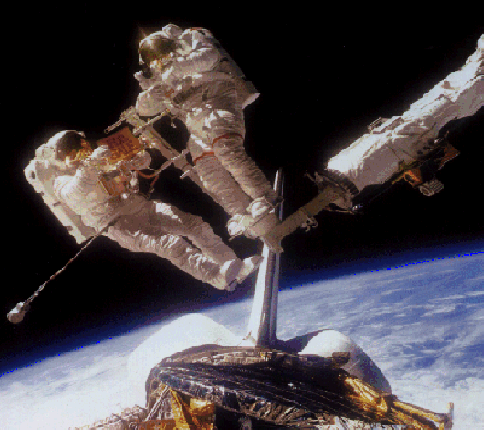Extra Vehicular Activity (EVA)

Dangers
The harsh environment of space challenges human survival. A
lack of oxygen and atmospheric pressure, intense radiation, and
the lack of gravity confront humans in space. The metals and
machines of our space vehicles ensure some safety, but a human
outside the protection of a spacecraft bears the brunt of the
danger.
Training
Astronauts on EVA face danger, but
they do not merely pull on a
spacesuit and stroll outside. Most EVA's are planned and well
practiced beforehand. Once assigned to a mission, astronauts go
to school. Attending classes on technical and theoretical
aspects of the mission, the astronauts also perform simulations
of procedures to be used during the mission. The simulations
are conducted in an environment as similar to space as possible
-- a swimming pool. A very special swimming pool, the
Weightless Environmental Training Facility, or
WETF, contains a
life size mockup of the space shuttle cargo bay. Here
astronauts put their classroom training to the test.
Tools
The classes also teach astronauts about the necessary tools for
EVA's. In addition to a spacesuit, an astronaut also carries a
manned maneuvering unit, or MMU.
Basically a backpack, this
device is propelled by gaseous nitrogen. It and the astronaut's
spacesuit are considered the smallest manned spacecraft ever
made. EMU lights are mounted on the
helmet to provide light in
shade. A TV camera, also mounted on the helmet, allows ground
support and shuttle crew to give better instructions during
problem situations. Tethers at the waist prevent tools from
floating off, and thermal mittens protect against extreme
temperatures. A checklist on a wrist provides procedures for
performing EVA tasks and correcting EMU problems.
Benefits
Extra vehicular activity, or EVA, is needed for many of our
tasks in space. The historic landing on the moon by Neil
Armstrong, Michael Collins, and Buzz Aldrin began a series of
lunar landings, the Apollo missions. These missions brought new
knowledge due to lunar surface explorations -- all EVA's. In
addition, many of the satellites that now ring our planet are
launched, repaired, and serviced during EVA's, providing
increased communications. More than easing the passing of
voices and information around the globe, more than increasing
mankind's knowledge banks, EVA's demonstrate the awesome
immensity that surrounds our world, and mankind's ability to
exist in it.
Class Discussion
- The WETF mimics the microgravity of
space as close as possible,
yet the human body is buoyant. How do the astronauts keep from
rising to the surface while performing underwater experiments?
- In space it is much more difficult to work because the lack of
gravity leaves nothing to provide leverage. Every movement will
not only displace the object being worked on but also the
astronaut as well. How do astronauts maintain leverage? Can
you name any device that helps in such situations?
- Name some examples of extra-vehicular activity that you have
heard about, or what you think astronauts do on EVA's.
- The EMU light provides illumination in
shady work areas. Where
could you find shade in space?
Class Activities and Research
- Find out if there are other ways to simulate microgravity on
Earth. What does the United States use in its space program?
What did the Soviet Union use to train their astronauts?
- What was the most recent EVA about?
- Discuss what you think an astronaut feels like on an EVA. Write
a letter to an astronaut who has been on a space walk. Ask what
did he or she did on EVA, what he or she thought or felt.
- How many astronauts from other countries have been involved in
EVA's?
